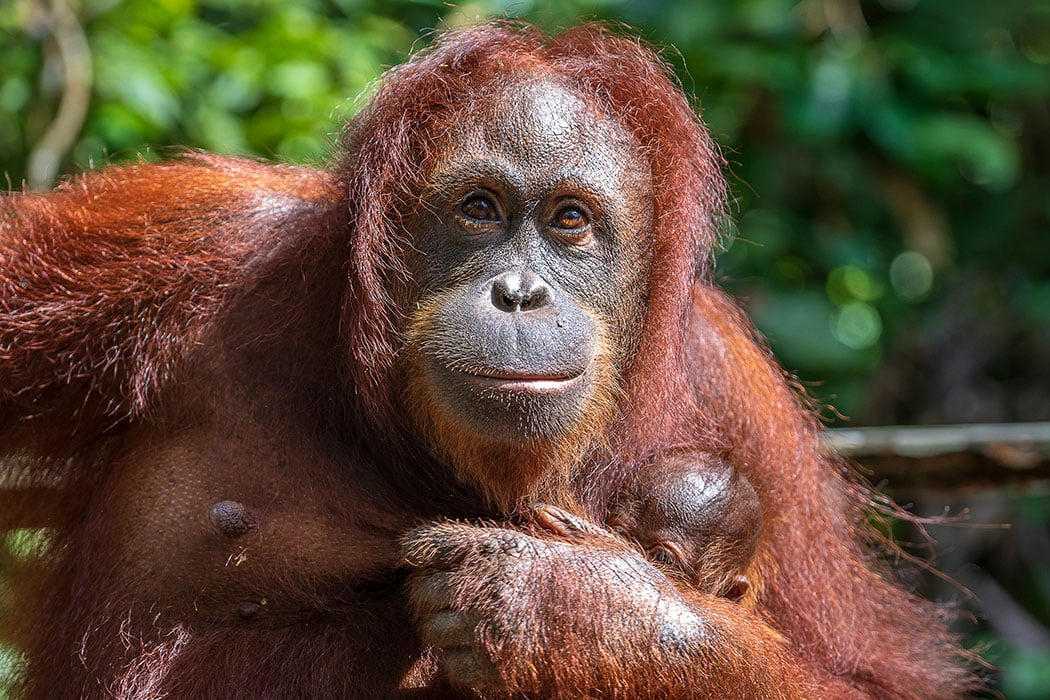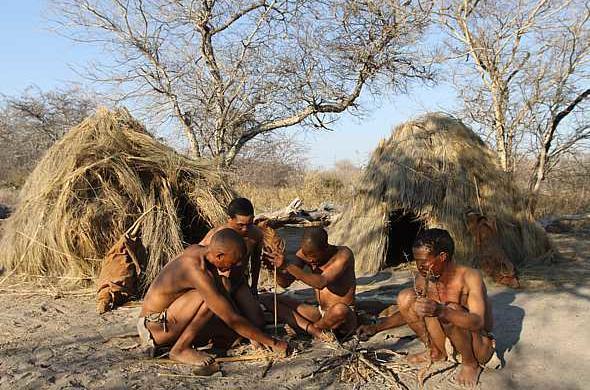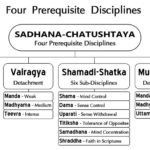David Attenborough’s – Life of Mammals 10 Food For Thought
Full video at the bottom.

Opens with shots of an orangutan on a boat using her hands to pedal his way. Then using soap on her hands. Then tying a boat to a ladder. Then using the water and soap to wash clothes. David’s sitting next to her confirming she’s not learnt this as circus tricks. She’s learnt by watching others do it. Using hands and tools which started by monkeys is brought to a much greater level… to lead the transformation of the world.
Over to Camp Leakey. Home to a special group of orangs rescued from captivity and returned to the wild. They show a ‘lady’ that loves DIY with hammer in hand and a nail in her mouth. Whoa… and her son has a saw in hand. And the little one in her hand is interested too. Mom starts sawing as David points out similarities… especially the handedness as he points out lady orang is lefthanded.
And we’re off to the trees. Apes love fruit. Now orangs hardly come down from the trees, mostly coz of dangers. Shots of orangs pole vaulting across trees, using their weight to make them bend to get to the neighbouring tree. Since it uses up a lot of energy they take direct paths and seldom take wrong tunes. Like they have a map of the forest in their minds. There is also proof of a mental calendar, always there at the right time to pick the right fruits. Shot of mother letting baby use her hand to get around. It takes around 13 years for the baby to get the ‘hang’ of things. They they only ones that spend such a long time with their mothers… except humans. But that too has to end. Orangs are known as loners but that does not mean they’re anti social. Feeding time at Camp Leakey proves they’re only loners for their food needs.
Every 4-5 years lots of trees produce fruit simultaneously attracting orangs from miles around. Of course theres always a troublemaker, in this case a highly sexed male that chases a chosen partner and tries to force himself of the female. A howl announces the most powerful males arrival. He’s not been there for years but the rest recognize him instantly. And just the threat of his presence gets rapist orang to hit the branches.

Gorgeous shots of the swamp forests of Northern Sumatra. Trees in the mist highlighted with sunset. Loving it! A paradise for orangutans. The regular floods bring in large supplies of nutrients. Here they can feed together throughout the year. Munching on insects as well. Termites being a favourite. Getting them from dead trees is fine but from living ones gets tricky. Clever orangs have a way… first they chose a twig, then cut it to length, then whittle it to shape. And finally insert it into the tree to reach the sixlegged goodies. Okay? This orang is messing with bees. Puts the stick in his mouth and inserts the other end in the hole. Then switches sides so while he pokes around he can get some tastes of honey. Young’ns watch and learn. That’s how they form a culture if they live in high densities. One gets a bright idea, the others copy it.
Over to a more complex ape culture… Chimpanzees in Africa! Near the mouth of the Congo. Shot of orphan chimps. Their parents were killed for the bush meat trade while they were captive in not-so-favorable conditions. So now they’re part of an experiment to teach them the skills they need to survive out there. Insect repellent, torch and matchbox… just messing. Lol one of them raided the canoe David was being rowed on. Ok so several learnt stuff by watching humans. Like cracking nuts with a block of wood. It still took them a number of years to figure how to place the nut in a socket first and then how to weald a hammer. While one chimp goes to it, another watches attentively. Yet another is struggling as he only started watching nuts being cracked since he was 6. That’s 2 years too late. Comic shots of frustrated chimp. Shots of David chilling with them.

Up next… a 1000miles east… Uganda. Ngogo chimps with a very different culture and have never been filmed before. This chimp community contain the most adult males known anywhere. Their cultural traditions extend to the details of social etiquette. They practice a style of grooming known as the grooming hand clasp. Hmmm they are peaceful but now and then set trip like they lost the plot. But that’s just for the male to establish his dominance without getting physical with those he may need as comrades. After throwing them fits they embrace one another. Aint that sweet. Now very rarely the adult males will get gangsta on an individual and the violence is unbelievable. Seriously wounded shot of victim chimp. It’s almost certain that he died. Almost? Oh his body has not been found yet. Some theory about lots of males and establishing relations being the reason for such behaviour. Even simple acts of grooming have great significance. Not only for health and keeping relations but also for earning allies. Hunting time! Attentions are turned to the trees. Males are assembling. One of them drums, telling the others that the hunt is about to start. They set off… for up to 4 hours… searching for likely victims. They find a troop of red colobus monkeys. Hunters take up their positions on surrounding trees ready to pounce escapees. They close in on the most vulnerable target… female with her young. Colobus try to fight back but chimps are bigger and stronger. Easy prey are the infants separated from their mothers. The male colobus fight to defend their families. But they couldn’t save some. The hunters crowd round the kill… the rest join. Males eat first, supplementing the meat with leaves. Like humans with veggies. Some share with females… seems like they share with the ones that beg most. Lil Porkpie begs so many and just gets slapped away till finally he gets a bite. Males give their meat more to their allies. Like they want to strengthen the bond. Clever, social, political creatures… and apparently they even dream.
/olduvai-gorge-165830429-5c3e4a83c9e77c00011d0ebb.jpg)
Ah good old Olduvai Gorge in Tanzania. Who remembers those history lessons? 3.5 million years ago… a volcano belched out ash that covered the entire landscape. Fossilized traces of ancient rhino and antelope can be found in this ash. And then there’s footprints of a very remarkable ape. Scientist say they can tell the posture of the animal just form the bone, which can always be debated… but here we have proof… as David takes us through the dents of the footprint. Apart from the depression made mostly be heel and front, David also points out that the toes are facing forward and not spread out like they would be if the animal was a tree climber. Trying to google the name but cant find this Itoli thing. The main footprints have baby ones next to them. David suggest they may be walking arm in arm. Anyway the fascinating thing is they’re behaviour was fossilized too… and most astonishingly familiar behaviour. Why did they stand upright? Suggestion are maybe to get a better view of things. Maybe to use the hands for tools and pick up food. And a 3rd controversial suggestion.
About 6 million years ago the climate became very erratic. The great African forests began to die back. The blanket of trees broke and became patches of grassland. Evidence that slow movement of the earths crust cause some areas to flood. A new habitat appeared for the apes. As food got harder to find they had to cross the waters and grassland… and they did so as David shows us with extra high waders in the water. Shots of these apes walking around… they got some crazy nipples! Since they waddled when walking and couldn’t stand for long the water helped take a step towards humanity. This is where the hipbones altered and our ‘ancestors’ adopted a more upright existence.
Back to Congo to get a clue as to what the apemen would have found to eat in the swamps. Lowland gorillas collect marsh plants. Our ancestors must have done the same. We do know that roots and tubers were eaten by early humans. Although gorillas are veggies, the surrounding animals would not have gone unnoticed by early apemen. Hey look Bambi! Yet to catch the animals would require another skill. A skill to follow their tracks. Finding tracks, telling what animal came by and when… only humans can do so. Obvious tracks can be read by anyone but there are some people that can read the faintest of marks.

Shot of the San People of the Kalahari desert. Shot of one of them doing what looks like a gang hand sign. They hunt in silence. The hand sign indicates that one of them has tracks of kudu. They are the last people to use what some believe to be the most ancient hunting technique of all. The persistence hunt, they run down their prey. They start to feel the animals movements from the spacing of the animals tracks… dude moves this hand sign to reconstruct the head movement. The group is not moving fast… soon San People catch up. Animals take fright/flight. They target the bull carrying the more heavy set of horns so he’ll tire more quickly. Wicked shot of San People running at slow/normal speed and clouds moving/forming/vanishing at high speed. They must separate heavyhorns from the herd so as not to confuse his tracks to the others. These guys are patient! They sense the kudu’s pace is slowing. Sun directly over head. After hours of trekking, they’ve entered an almost trancelike state of concentration. At times its hard to see the tracks so the Peoples must image. The heat is hard on them but they’re close to the next stage of the hunt. The chase. One of the dudes chucks his stick as a sign for the chase to begin. But only the runner will undertake it. The test of endurance… running on 2 feet is much easier than on 4. Man sweats from all over to cool himself, the kudu sweats much less and has to find shade to cool down. Man has hands to hold water bottles ;o) Hours pass as dude gets closer and still doing his hand gestures. Aw naw! Kudu runs into thick cover and the tracks disappear. Dude reconstructs again and deduces the direction kudu must have fled. Its close by. The chase lasted 8 hours. Kudu collapses from exhaustion before dude could spear him. No man! Dude still speared kudu. David calls it a symbolic gesture. Dude pays tribute to the courage and stuff with ceremony and gestures to show that it spirit returns to the desert sand from which it came. While it was alive he lived and breathed with it as if it was his own body. He shares the pain at its death. He rubs the its saliva on his leg to relieve the agony of his burning muscles. And he gives thanks for the life he has taken to sustain the life of his family. The wives had collected tubers and roots. Wild dogs are given scraps.
David notes that wild dogs must have stuck around for scraps since pre-history. Men selected pups that were least savage to help in tracking. The character of their dogs began to change. Cattle were domesticated by a similar process. Choosing the most docile calves and hand rearing them. The Fulani people of Mali lay claim to the half wild herds that run the savannahs.
Amazon #ads
Grazing animals must migrate to find greener pastures. And the people with them. To be able to domesticate and animal they need to be docile, find food that’s readily available, to breed easily in captivity and last to live in pack or herds or groups. That way the man can find the leader and take over his place. Something about animals having to cross treacherous waters to get to food. Just keeping the tame ones alive is full of difficulties. David talks about how good we’ve become at taking care of them that domesticated cattle far out number their wild relatives. Yeah right… Watch Earthlings on google video and see just how ‘good’ we are. Anyway he goes on to talk about cattle being able to provide not only milk and meat but power. So people can settle down and plant crops and become farmers. Woodlands and grasslands began to disappear and replaced with domesticated crops and farms. People began to grow/select plants which gave good yields and so plants also changed. People all over the world began to settle down into their villages. You go where food is, your survival depended upon it. Now humans started making far beyond that which occurred naturally. Human numbers began to increase. Talks about how important millet is to this village. More houses to contain millet than there are to contain human beings. The first sound the baby will hear in the Dogon village is that of its mother pounding millet. Since they didn’t have to chase around for food they had more time. Rituals and the arts flourished. Music time! Masks and shields and etc. With all this flourishing… villages became towns. Towns became cities.
David takes us to the site of the oldest city in Africa below the Sahara. An area full of pot pieces. The remains of 2000 years of continuous human occupation. The city still flourishes just next to this site. Didn’t get the name. In its heart stands the mosque… the oldest and largest mud building in the world. The places growth was closely tied to the neighboring city… Timbuktu. Between them, they dominated the trade across the sahara. Folks would come from all over for slaves and gold and ivory and trade still dominates the city. This helped people escape the food hunt and get into craft to make things in exchange for food.
Ah finally the bit I’ve been dying to watch. Tical … the capital of the Maya people. They built the tallest structures in the New World. About 1300 years ago… the city covered a vast area. At least double the size of ancient Rome. Only a fraction of temples and houses can be seen today. Such beautiful shots! The inhabitants excelled in every form of civilized activity. Sculptors, builders, astronomers. They constructed complex calendars to which their religious beliefs were closely tied. And they devised a system of writing that was, in its time, the most advanced in all the Americas. Having achieved all this… when and why where their cities abandoned. We do have some clues. Maya recorded their history in great detail… on stones. The latest inscription can be dated to 869AD. After that the city falls silent, the inhabitants disappear and the classic Maya civilization came to an end. All the whys are a hot debate. Well and good. But now there’s new evidence and to see it we gotta get above the city. Aquaducts, canals and a dense network of fields under the soil have been revealed by the cameras in the air. Evidence that by the time the temples were built, the surrounding forsests had already been felled and replaced by great expanses of cultivated fields. As the population grew, probably to about 60,000, the farmers struggled to grow enough. Eventually the fertility of the fields was exhausted. Soon the people were starving and drifted away from the city. And gradually the jungle returned.

The relevance to us today? When they built their cities there were only about 50 million people on the planet. Maya were not able to sustain their population with the technology they developed as sophisticated as it was. Then few years later… human beings elsewhere with newly developed techniques, began to build on a scale that dwarfed the skyscrapers of Tical. Highspeed shots of different cities in our world today. 50 million turned to 6000 million people on Earth. All these people need food. And we have long since utilized the most suitable fertile places, now we’re having to try to do so elsewhere.
Like a desert in Arizona. Suddenly we’re at a lush field. Thanks to humanity’s unique capacity to innovate and to learn. They bring rain to the desert! Every year we displace the equivalent of entire rivers in order to water our crops. Over a third of the land is being used to produce food for human beings. And that has changed some landscapes in the most dramatic way. Natural landscapes have been turned into landscapes of geometrical straight lines. Shots of rectangles of different shades of green to tan. All this started when our hands were freed and we could manipulate our surroundings. Our ingenuity has enabled us to use the most unlikely and unpromising corners of the Earth. Even beginning to farm the oceans. The changes we’ve made are so wholesale that they’re now visible from space. And as our numbers increase, there’s less land for other animals and plants. We cant contstantly expand… will our civilization crumble as the Mayan did?

Over to a launch pad in the US. David talks about an attempt to settle in another planet in 2020. The ape that stood up on its hind legs seems to have out grown its planet. Could it settle in Mars? There the energy giving sunlight is only half as intense. And the cold reaches below more than a 100 degrees below freezing. Will our technology be able to meet this challenge? Well someones working on it! So we might need more kinds of food than we’ve been relying on for the past years. Which is why we’re conserving the species which we’ve been so careless with. WE? Ok ok we. David in a giant greenhouse looks optimistic about being able to hook Mars up with one of these. So if we could do Mars… could we do other planets after? This all began when humans first landed on the moon. Is that as far as we will reach… or should reach?
Back to those fossilized footprints… 3.5 million years separate those footprints to the footprints on the moon. A mere blink in the eye of evolution. David preaches about exploiting this planet and now another. Perhaps the time has now come to put that process into reverse. Instead of controlling the environment for the benefit of the population… perhaps its time to control the population to allow the survival of the environment.
Final Paras note: The Life of Mammals series can be found at www.parasuniversal.com and if you liked the Attenborough knowledge do let me know as I have Planet Earth episodes and Life in the Freezer episodes.
1. A Winning Design | 2. Insect Hunters | 3. Plant Predators
4. Chisellers | 5. Meat Eaters | 6. The Opportunists
7. Return to the Water | 8. Life in the Trees | 9. The Social Climbers
10. Food for Thought





